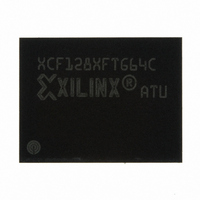XCF128XFTG64C Xilinx Inc, XCF128XFTG64C Datasheet - Page 14

XCF128XFTG64C
Manufacturer Part Number
XCF128XFTG64C
Description
IC PROM SRL 128M GATE 64-FTBGA
Manufacturer
Xilinx Inc
Datasheet
1.XCF128XFTG64C.pdf
(88 pages)
Specifications of XCF128XFTG64C
Memory Size
128Mb
Programmable Type
In System Programmable
Voltage - Supply
1.7 V ~ 2 V
Operating Temperature
-40°C ~ 85°C
Package / Case
64-TBGA
Access Time
85ns
Supply Voltage Range
1.7V To 2V
Memory Case Style
FTBGA
No. Of Pins
64
Operating Temperature Range
-40°C To +85°C
Svhc
No SVHC (15-Dec-2010)
Package /
RoHS Compliant
Lead Free Status / RoHS Status
Lead free / RoHS Compliant
Other names
122-1578
Available stocks
Company
Part Number
Manufacturer
Quantity
Price
Company:
Part Number:
XCF128XFTG64C
Manufacturer:
XILINX
Quantity:
319
Part Number:
XCF128XFTG64C
Manufacturer:
XILINX/赛灵思
Quantity:
20 000
The only operation permitted during Blank Check is Read
Status Register. Dual Operations are not supported while a
Blank Check operation is in progress. Blank Check
operations cannot be suspended and are not allowed while
the device is in Program/Erase Suspend.
The SR7 Status Register bit indicates the status of the
Blank Check operation in progress:
•
•
The SR5 Status Register bit goes High (SR5 = '1') to
indicate that the Blank Check operation has failed.
At the end of the operation the bank remains in the Read
Status Register mode until another command is written to
the Command Interface.
See
the Blank Check command.
Typical Blank Check times are given in
Program Command
The program command is used to program a single word to the
memory array. If the block being programmed is protected,
then the Program operation aborts, data in the block is not
changed, and the Status Register outputs the error.
Two Bus Write cycles are required to issue the Program
Command.
•
•
After the programming starts, read operations in the bank
being programmed output the Status Register content.
During a Program operation, the bank containing the word
being programmed only accepts the Read Array, Read
Status Register, Read Electronic Signature, Read CFI
Query and Program/Erase Suspend command; all other
commands are ignored. A Read Array command is required
to return the bank to Read Array mode.
Refer to
page 35
operations allowed in banks not being programmed.
Typical Program times are given in
The Program operation aborts if Reset (RP) goes to V
data integrity cannot be guaranteed when the Program
operation is aborted, the word must be reprogrammed.
See
Program command.
DS617 (v3.0.1) January 07, 2010
Product Specification
SR7 = '0' indicates that the Blank Check operation is
still ongoing.
SR7 = '1' indicates that the operation is complete.
The first bus cycle sets up the Program command.
The second latches the address and data to be
programmed and starts the Program/Erase Controller.
Figure 38, page
Figure 37, page
"Dual Operations and Multiple Bank Architecture,"
for detailed information about simultaneous
R
72, for a suggested flowchart for using
71, for the flowchart for using the
Table 21, page
Table 21, page
44.
Platform Flash XL High-Density Configuration and Storage Device
IL
www.xilinx.com
44.
. As
Buffer Program Command
The Buffer Program Command makes use of the device’s
32-word Write Buffer to speed up programming. Up to 32
words can be loaded into the Write Buffer. The Buffer
Program command dramatically reduces in-system
programming time compared to the standard non-buffered
Program command.
Four successive steps are required to issue the Buffer
Program command:
1. The first Bus Write cycle sets up the Buffer Program
2. The second Bus Write cycle sets up the number of
3. A total of n + 1 Bus Write cycles are used to load the
4. The final Bus Write cycle confirms the Buffer Program
All the addresses used in the Buffer Program operation
must lie within the same block. Invalid address
combinations or failing to follow the correct sequence of Bus
Write cycles sets an error in the Status Register and aborts
the operation without affecting the data in the memory array.
If the block being programmed is protected, an error is set in
the Status Register, and the operation aborts without
affecting the data in the memory array.
During Buffer Program operations, the bank being
programmed only accepts the Read Array, Read Status
Register, Read Electronic Signature, Read CFI Query and
Program/Erase Suspend command; all other commands
are ignored.
Refer to
page 35
operations allowed in banks not being programmed.
See
the Buffer Program command.
command. The setup code can be addressed to any
location within the targeted block.
After the first Bus Write cycle, read operations in the
bank output the contents of the Status Register. Status
Register bit SR7 should be read to check that the buffer
is available (SR7 = 1). If the buffer is not available (SR7
= 0), the Buffer Program command must be re-issued to
update the Status Register contents.
words to be programmed. Value n is written to the same
block address, where n + 1 is the number of words to be
programmed.
address and data for each word into the Write Buffer.
Addresses must lie within the range from the start
address to the start address + n, where the start
address is the location of the first data to be
programmed. Optimum performance is obtained when
the start address corresponds to a 32-word boundary.
command and starts the program operation.
Figure 39, page
"Dual Operations and Multiple Bank Architecture,"
for detailed information about simultaneous
73, for a suggested flowchart on using
14





















